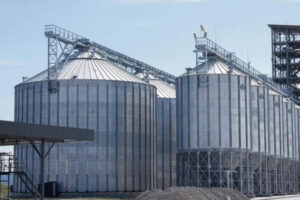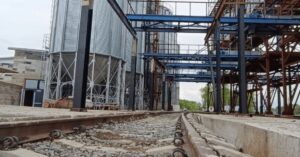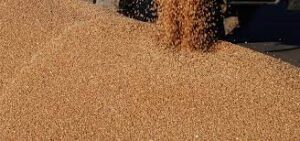
An elevator that will be able to store up to 30,000 tons of grain at a time, as well as a dry port, will be built in the Lviv region, according to Maksym Kozytskyi, head of the Lviv Regional Military Administration.
“This is the beginning of a large-scale project that includes hundreds of grain storage facilities throughout Ukraine, a network of dry ports, modern logistics hubs, deep processing plants, bioclusters, new export opportunities, and technological upgrades for the agricultural sector,” he wrote on his Facebook page.
A memorandum of cooperation was signed by the Lviv Regional State Administration, the Lviv Regional Council, the Belz City Council, and AgHoldCo, which, with the support of the UAF Partners investment fund, will finance 80-85% of the project’s cost. The Danish State Export Agency EIFO is also expected to contribute to the financing, thanks to which AgHoldCo intends to secure a $12 million loan for the construction of each elevator.
The contribution of the Belz community is estimated at no less than $3 million for each of the subprojects. This assistance will also include the selection and allocation of land plots, connection of the facility to engineering networks, and tax incentives.
The head of the Lviv Regional State Administration expressed confidence that the construction of the elevator and dry port in the region will provide jobs, help reduce grain transportation costs, and strengthen food security in the Lviv region. In addition, it will be easier for small and medium-sized farms to store grain.

The multimodal terminal of the Fiska-Nov company will be launched in the territory of the Hlybotska community (Chernivtsi region), near the border with Romania, the community’s press service reported.
“The launch of this terminal will be an important step in the development of transport infrastructure, increase the transit potential of the region, and contribute to economic growth at both the local and national levels. In addition, its location near the border with Romania gives it strategic importance for transportation between Ukraine and the European Union,” the community said.
The facility’s infrastructure includes six railway tracks and special equipment that allows for transshipment between Ukrainian 1,520 mm gauge and European 1,435 mm gauge railcars. The terminal will also accept cargo by road. The purchased and installed load cells are designed to ensure accurate weight control of cargo during loading and unloading.
The Fiska-Nov company plans to create about 100 new jobs.
Oleg Nivievsky, Chairman of the Center for Food and Land Use Research at the Kyiv School of Economics, praised the community’s initiative on Telegram, which took advantage of the feasibility study developed by KSE in 2023 for the construction of a dry port on the border with Poland.
“The result was quite unexpected but pleasant — such projects are economically viable even without state support. Why is this important? Because improving and increasing the capacity of communications with the EU is a kind of insurance against a ‘crazy’ neighbor. In other words, it is something that can be supported with taxpayers’ money, but here the result is that everything looks good without support,” the scientist summed up.

A dry port is being built in the Vinnytsia community to help connect the central regions of the country with the ports of Odesa and the EU countries through the Mostyska container terminal, with an investment of $15 million, Vinnytsia Deputy Mayor Andriy Ocheretnyi wrote on Facebook.
“This will be a railroad terminal that will improve the prompt transportation and handling of cargo, as well as the export and import potential of our country. It will help to connect the central regions of the country with the ports of the big city of Odesa and, through the Mostyska container terminal, with the EU countries,” Ocheretnyi emphasized.
According to him, the first phase of construction began in the spring of 2024. At the first stage of the dry port construction, the railway infrastructure and the first container yard with a capacity of about 30 thousand TEU/year will be built. Meanwhile, 2000 TEU is the capacity of the container warehouse, which will also be built at this stage.
Currently, part of the railway tracks, a weighing system, and a 3.5 thousand square meter warehouse are ready.
“The Dry Port is scheduled to be commissioned in the third quarter of this year. It will employ about 50 people and is currently looking for machine operators. A total of 100 jobs are planned to be created, summarized the deputy mayor of Vinnytsia.

A “dry port” for grain exports to Europe will be built in the village of Horonda, Mukachevo district, Zakarpattia region, the press service of the Zakarpattia Regional State Administration reported on Facebook.
“A multimodal logistics hub for grain exports to the EU will appear in Zakarpattia. We are working with Italian investors to implement the Horonda Platform project in the village of Horonda, Mukachevo district,” said Viktor Mykyta, head of the Transcarpathian Regional State Administration.
According to him, the project provides for the creation of opportunities for transshipment of agricultural products from a wide to a narrow road, the emergence of storage facilities, and the provision of a center with containers for grain, sunflower oil, etc. Horonda Platform is expected to create more than 200 new jobs in the Zakarpattia region.
“The emergence of such a land grain corridor in our region is a priority task of national importance. This project is especially important in times of war. We are grateful for the great trust of the country’s leadership and international investors,” emphasized Mykyta.
Representatives of the Italian companies involved in the project, including FS Holding, Mercitalia Rail, and Mercitalia Terminal, emphasized that they are interested in strengthening communication with the Ukrainian side, including Zakarpattia, in socio-economic, legal, and other aspects.
dry port, FS Holding, Horonda Platform, Mercitalia Rail, Mercitalia Terminal